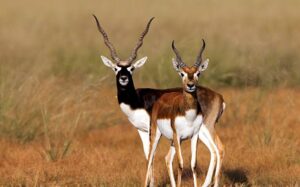Published on: January 11, 2023
Black Buck
Black Buck
Why in news? A study conducted by the Indian Institute of Science (IISc) has highlighted on how the blackbuck has survived in India by facing of natural and human-induced challenges
Highlights
- It is the first of its kind in its scope, which involved analysing the genetic profiles of blackbucks found across the country.
- Faecal samples of blackbuck from 12 different locations spread across eight States of India were collected
- In the lab, they extracted and sequenced the DNA from the faecal samples to study the genetic makeup of blackbuck, and deployed computational tools to map the geographic locations with the genetic data
What are the major findings?
- Ancestral blackbuck population first split into two groups: the northern and the southern cluster
- The eastern cluster seems to have emerged from the southern cluster.
- Despite all odds, male blackbuck appear to disperse more than expected, contributing to gene flow in this species.
- Females, on the other hand, appear to stay largely within their native population ranges, which the researchers inferred from unique mitochondrial signatures in each population.
About Black Buck
- It is also known as the Indian antelope
- Native : India and Nepal and it is locally extinct in Pakistan and Bangladesh.
- Habitat: Grassy plains and lightly forested areas with perennial water sources
- Threats : Excessive hunting, deforestation, and habitat degradation.
- Protection : Hunting is prohibited under Schedule I of the Wildlife Protection Act of 1972 and listed under Appendix III of CITES
- IUCN Status: Least Concerned
Protected areas in India:
- Gujarat: Velavadar National Park, Gir Forest National Park
- Bihar: Kaimur Wildlife Sanctuary
- Maharashtra: Great Indian Bustard Sanctuary
- Madhya Pradesh: Kanha National Park
- Rajasthan: Tal Chhapar Sanctuary, National Chambal Sanctuary, Ranthambhore National Park
- Karnataka: Ranibennur Blackbuck Sanctuary;
- Tamil Nadu: Point Calimere Wildlife and Bird Sanctuary, Vallanadu Wildlife Sanctuary, Guindy National Park.
- Captive population is maintained in Pakistan’s Lal Suhanra National Park.
- Blackbucks in Great Indian Bustard Sanctuary show flexible habitat use as the resources and risks change seasonally in the landscape.

